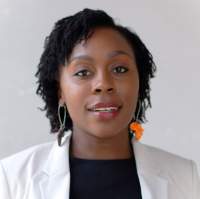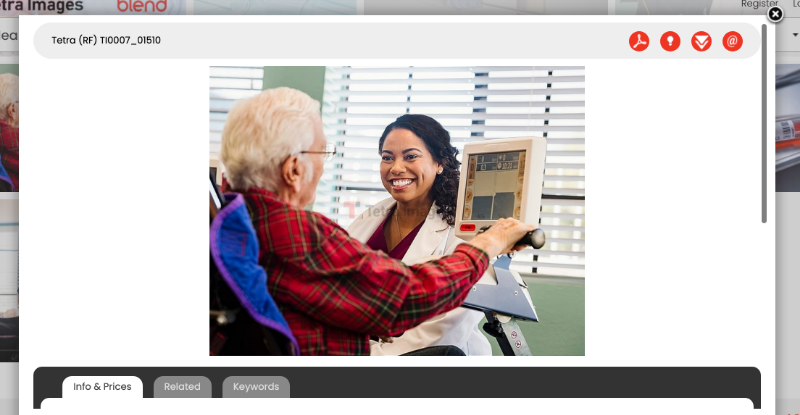- Equity, inclusion and sanitation workers
- Representation and equality in visual communication
- Using image composition to avoid hierarchies
Using image composition to avoid hierarchies
5085 views
- Chaiwe
-

- Moderator
- Innovation enthusiast and Knowledge Management Expert in WASH and Climate Change while cross-cutting Youth and Gender Issues. CEO of CaDev_Capacity Development (An African Social Enterprise)
Less- Posts: 336
- Karma: 8
- Likes received: 116
Dear Elisabeth,
I appreciate you sharing the Wikipedia extract. It provides clear directives. I can not however imagine that there is any country that does not have laws/ related laws on this subject. It strongly borders on human rights. Consent (even verbal) should be sought. I would recommend that anyone taking and intending on using (on social platforms or other) images of another person first seek their consent. Surely I can not see it any other way.
What is permissible can also be dictated by different cultural/ religious norms and beliefs. A case example is how in some parts of Asia or Africa people believe one steals/ imprisons their soul if an image of them is captured.
Away from just knowledge sharing, I wonder whether there is anything 'tangible' coming out of this discussion? A documented guide on WASH sector images perhaps? WASH sector stock photos? @Janice, would you know?
Best,
Chaiwe
I appreciate you sharing the Wikipedia extract. It provides clear directives. I can not however imagine that there is any country that does not have laws/ related laws on this subject. It strongly borders on human rights. Consent (even verbal) should be sought. I would recommend that anyone taking and intending on using (on social platforms or other) images of another person first seek their consent. Surely I can not see it any other way.
What is permissible can also be dictated by different cultural/ religious norms and beliefs. A case example is how in some parts of Asia or Africa people believe one steals/ imprisons their soul if an image of them is captured.
Away from just knowledge sharing, I wonder whether there is anything 'tangible' coming out of this discussion? A documented guide on WASH sector images perhaps? WASH sector stock photos? @Janice, would you know?
Best,
Chaiwe
SuSanA Forum Moderator
Skat Foundation (With financial support by GIZ and SIRWASH up to November 2023)
Chaiwe Mushauko-Sanderse BSc. NRM, MPH
Independent consultant located in Lusaka, Zambia
Emails: This email address is being protected from spambots. You need JavaScript enabled to view it., This email address is being protected from spambots. You need JavaScript enabled to view it.
LinkedIn: www.linkedin.com/in/chaiwe-mushauko-sanderse-21709129/
Twitter: @ChaiweSanderse
Skat Foundation (With financial support by GIZ and SIRWASH up to November 2023)
Chaiwe Mushauko-Sanderse BSc. NRM, MPH
Independent consultant located in Lusaka, Zambia
Emails: This email address is being protected from spambots. You need JavaScript enabled to view it., This email address is being protected from spambots. You need JavaScript enabled to view it.
LinkedIn: www.linkedin.com/in/chaiwe-mushauko-sanderse-21709129/
Twitter: @ChaiweSanderse
Please Log in to join the conversation.
You need to login to reply- Elisabeth
-
- User is blocked
- Freelance consultant since 2012
Less- Posts: 3372
- Karma: 54
- Likes received: 932
Re: Using image composition to avoid hierarchies
This was an interesting conversation. Chaiwe said "The images instantly reveal the stereotypical vulnerability you speak about... Or does it portray the reality? When and how do we distinguish between these two realities?" This made me think of photos showing women and girls carrying water over long distances in the heat in rural areas of Africa (for example). If such a photo is taken and shown, then does it reinforce stereotypes or does it simply show the (current) reality? Should we rather pick the rare photo of a male person carrying a load of water even though it's not representative but to ensure people become aware that men could carry water as well? I am finding these deliberations difficult.
The suggestion of the camera angle is an interesting one (top down versus eye level or perhaps even bottom up in some cases?). Little things like that could make quite a difference.
With regards to permission, I've looked it up previously for images stored on Wikimedia Commons (the image repository of Wikipedia):
I found this page which explains the issues well:
commons.wikimedia.org/wiki/Commons:Photo..._identifiable_people
It says for example:
+++++++
The subject's consent is usually needed for publishing a photograph of an identifiable individual taken in a private place, and Commons expects this even if local laws do not require it. In many countries
(especially English-speaking ones) the subject's consent is not usually needed for publishing a straightforward photograph of an identifiable individual taken in a public place. However, the term "publishing"
should not be construed to include commercial use , as consent is usually required in these situations. Moreover, the country specific consent requirements vary. Many factors can determine whether and what degree of consent is required.
In most countries, these issues only affect images where the person is identifiable and still alive. Certain legal and ethical issues may remain if the person is dead or if they cannot be identified.
+++++++++
So the key would be that the photo is taken in a public space and that the person should not be identifiable.
Regards,
Elisabeth
The suggestion of the camera angle is an interesting one (top down versus eye level or perhaps even bottom up in some cases?). Little things like that could make quite a difference.
With regards to permission, I've looked it up previously for images stored on Wikimedia Commons (the image repository of Wikipedia):
I found this page which explains the issues well:
commons.wikimedia.org/wiki/Commons:Photo..._identifiable_people
It says for example:
+++++++
The subject's consent is usually needed for publishing a photograph of an identifiable individual taken in a private place, and Commons expects this even if local laws do not require it. In many countries
(especially English-speaking ones) the subject's consent is not usually needed for publishing a straightforward photograph of an identifiable individual taken in a public place. However, the term "publishing"
should not be construed to include commercial use , as consent is usually required in these situations. Moreover, the country specific consent requirements vary. Many factors can determine whether and what degree of consent is required.
In most countries, these issues only affect images where the person is identifiable and still alive. Certain legal and ethical issues may remain if the person is dead or if they cannot be identified.
+++++++++
So the key would be that the photo is taken in a public space and that the person should not be identifiable.
Regards,
Elisabeth
Dr. Elisabeth von Muench
Freelance consultant on environmental and climate projects
Freelance consultant on environmental and climate projects
Please Log in to join the conversation.
You need to login to reply- JMitchell
-
 Topic Author
Topic Author- Curator for contemporary art with a focus on the intersection of art and politics – insistent on shifting the narrative. Member of the Neue Deutsche Museumsmacher_innen
Less- Posts: 5
- Likes received: 2
Dear Paresh, Thank you for your reply and for pointing this out. It was not a deliberate oversight and as you said, it shows how easy it is to repeat these patterns. What you said is true, that image or a similar image is missing from this post and previous posts. But it is one that should be there, it is quite significant in its meaning from multiple perspectives. Your comment and pointing out this oversight makes it clear how important it is to be mindful of what images are shown and which images are selected (and to check yourself!).It is helpful to keep track of who is shown, how often and in what context when making a selection. This may feel strange and counterintuitive, but it is helpful and gives you an overview of what images you’ve selected and what they represent. Inspired by your reply, I went through the databases that I linked, and also did a bigger search on Google/Getty Images to find such a photo. It was not that easy to find a photograph of such a situation or similar situation. I’ve attached some screenshots of the examples that I did find. Best, Janice
Curator for contemporary
Member of the Neue Deutsche Museumsmacher_innen
[Discussion lead Representation and Visual Culture]
Member of the Neue Deutsche Museumsmacher_innen
[Discussion lead Representation and Visual Culture]
Attachments:
-
 ScreenShot...6.43.png
(Filesize: 420KB)
ScreenShot...6.43.png
(Filesize: 420KB)
-
 ScreenShot...2.35.png
(Filesize: 283KB)
ScreenShot...2.35.png
(Filesize: 283KB)
-
 ScreenShot...8.24.png
(Filesize: 244KB)
ScreenShot...8.24.png
(Filesize: 244KB)
-
 ScreenShot...6.39.png
(Filesize: 181KB)
ScreenShot...6.39.png
(Filesize: 181KB)
-
 ScreenShot...7.08.png
(Filesize: 461KB)
ScreenShot...7.08.png
(Filesize: 461KB)
Please Log in to join the conversation.
You need to login to reply- JMitchell
-
 Topic Author
Topic Author- Curator for contemporary art with a focus on the intersection of art and politics – insistent on shifting the narrative. Member of the Neue Deutsche Museumsmacher_innen
Less- Posts: 5
- Likes received: 2
Dear Chaiwe, Thank you for your thoughts on this post. I do think that these images to a certain degree show reality; the viewer is looking at the outcome of a sanitation/water project. But the photos are highly stylized and composed in a way that enhances the vulnerability of the children shown and makes it the focus of the image, which in my opinion makes them exploitative.You’ve also made a great point when you say that these pictures don’t show the broader picture of what constitutes water and sanitation. They leave out any “behind the scenes” images: how a project is developed and carried out, the local partners and actors involved, the initial planning. I think these things are important and are something people would like to see as well. Showing the broader picture also makes it possible to move away from highlighting the vulnerability of these communities and instead shift towards the actual activities and projects. Consent is also an important issue and I asked myself the same thing when looking at the photos. I assume that in most cases, photographers don't ask for consent and certainly don't ask for permission to publish or sell the photograph. It should be standard though and is something that should talked about more so that people are more aware.
Best, Janice
Best, Janice
Curator for contemporary
Member of the Neue Deutsche Museumsmacher_innen
[Discussion lead Representation and Visual Culture]
Member of the Neue Deutsche Museumsmacher_innen
[Discussion lead Representation and Visual Culture]
Please Log in to join the conversation.
You need to login to reply- Chaiwe
-

- Moderator
- Innovation enthusiast and Knowledge Management Expert in WASH and Climate Change while cross-cutting Youth and Gender Issues. CEO of CaDev_Capacity Development (An African Social Enterprise)
Less- Posts: 336
- Karma: 8
- Likes received: 116
Dear Janice,
Great pointers for photography in general. However, I would like to know what your thoughts about water and sanitation imagery are. A simple google search on water and sanitation images see here . The images instantly reveal the stereotypical vulnerability you speak about... Or does it portray the reality? When and how do we distinguish between these two realities?
Scrolling down the search thread you see mostly children (and women) of Asian or African origin. One wonders, does the photographer seek consent from guardians to capture these images of children? These images do not communicate the broader picture of what constitutes Water and Sanitation.
That said, I wonder what your impressions are and the impressions of other experts out there.
Regards,
Chaiwe
Great pointers for photography in general. However, I would like to know what your thoughts about water and sanitation imagery are. A simple google search on water and sanitation images see here . The images instantly reveal the stereotypical vulnerability you speak about... Or does it portray the reality? When and how do we distinguish between these two realities?
Scrolling down the search thread you see mostly children (and women) of Asian or African origin. One wonders, does the photographer seek consent from guardians to capture these images of children? These images do not communicate the broader picture of what constitutes Water and Sanitation.
That said, I wonder what your impressions are and the impressions of other experts out there.
Regards,
Chaiwe
SuSanA Forum Moderator
Skat Foundation (With financial support by GIZ and SIRWASH up to November 2023)
Chaiwe Mushauko-Sanderse BSc. NRM, MPH
Independent consultant located in Lusaka, Zambia
Emails: This email address is being protected from spambots. You need JavaScript enabled to view it., This email address is being protected from spambots. You need JavaScript enabled to view it.
LinkedIn: www.linkedin.com/in/chaiwe-mushauko-sanderse-21709129/
Twitter: @ChaiweSanderse
Skat Foundation (With financial support by GIZ and SIRWASH up to November 2023)
Chaiwe Mushauko-Sanderse BSc. NRM, MPH
Independent consultant located in Lusaka, Zambia
Emails: This email address is being protected from spambots. You need JavaScript enabled to view it., This email address is being protected from spambots. You need JavaScript enabled to view it.
LinkedIn: www.linkedin.com/in/chaiwe-mushauko-sanderse-21709129/
Twitter: @ChaiweSanderse
Please Log in to join the conversation.
You need to login to reply- paresh
-

- Moderator
- Budding WASH researcher, especially interested in governance, public policy, finance, politics and social justice. Architect, Urban & Regional planner by training, Ex. C-WAS, India.I am a patient person :)
Less- Posts: 383
- Karma: 7
- Likes received: 143
Dear Janice,
Thanks for the useful tips. They also coincide with good photography tips.
Your posts together help drive two key points
I understand it wasn't deliberate, but that is exactly how most stereotypes are reinforced.. unknowingly.
Regards
paresh
Thanks for the useful tips. They also coincide with good photography tips.
Your posts together help drive two key points
- making images inclusive and as representative as possible
- not use images that reinforce stereotypes
I understand it wasn't deliberate, but that is exactly how most stereotypes are reinforced.. unknowingly.
Regards
paresh
Paresh Chhajed-Picha
Moderator, SuSanA forum
Project Manager at ADCPS
Indian Institute of Technology - Bombay, India
Moderator, SuSanA forum
Project Manager at ADCPS
Indian Institute of Technology - Bombay, India
Please Log in to join the conversation.
You need to login to reply- JMitchell
-
 Topic Author
Topic Author- Curator for contemporary art with a focus on the intersection of art and politics – insistent on shifting the narrative. Member of the Neue Deutsche Museumsmacher_innen
Less- Posts: 5
- Likes received: 2
Again and again images construct hierarchies between people, (re)produce stereotypes and establish a hierarchy between photographer/viewer and people depicted. I try to make sure that people are active or look active in the photos and that they’re not taken from above.
Especially photographs of children are taken mostly from the top down, but vulnerable groups are also often photographed in this way. Yet it makes the person photographed seem vulnerable and powerless. Furthermore, the viewer (and the photographer) is literally and metaphorically looking down on the person. If the photographer is at eye level with the person he’s photographing, the impression immediately changes. It often helps to choose images that do not clearly communicate hierarchies but leave space for interpretation and ambiguity.
Here are some images as examples. What do you think?
What can photographers do to avoid those hierarchies and establish a respectful visual communication at eye level instead? And what could useful criteria be when selecting photographs publications or online use?
Source: iwaria.com
Source: iwaria.com
Source: iwaria.com
Especially photographs of children are taken mostly from the top down, but vulnerable groups are also often photographed in this way. Yet it makes the person photographed seem vulnerable and powerless. Furthermore, the viewer (and the photographer) is literally and metaphorically looking down on the person. If the photographer is at eye level with the person he’s photographing, the impression immediately changes. It often helps to choose images that do not clearly communicate hierarchies but leave space for interpretation and ambiguity.
Here are some images as examples. What do you think?
What can photographers do to avoid those hierarchies and establish a respectful visual communication at eye level instead? And what could useful criteria be when selecting photographs publications or online use?
Source: iwaria.com
Source: iwaria.com
Source: iwaria.com
Curator for contemporary
Member of the Neue Deutsche Museumsmacher_innen
[Discussion lead Representation and Visual Culture]
Member of the Neue Deutsche Museumsmacher_innen
[Discussion lead Representation and Visual Culture]
Attachments:
The following user(s) like this post: ddiba
Please Log in to join the conversation.
You need to login to reply
Share this thread:
- Equity, inclusion and sanitation workers
- Representation and equality in visual communication
- Using image composition to avoid hierarchies
Recently active users. Who else has been active?
Time to create page: 0.234 seconds










